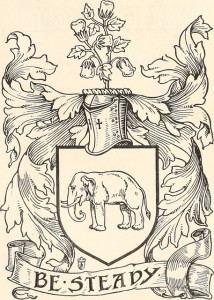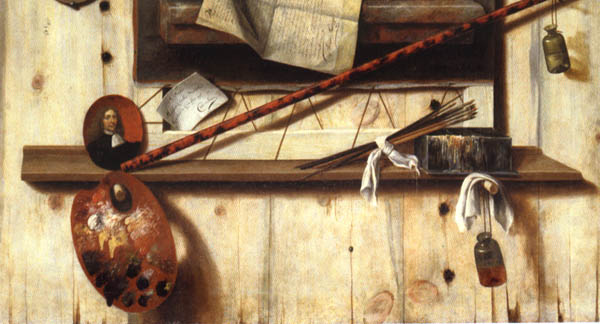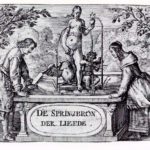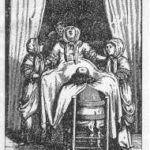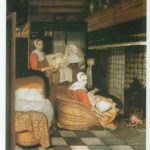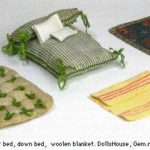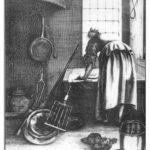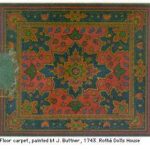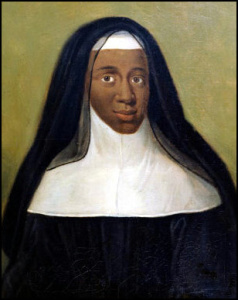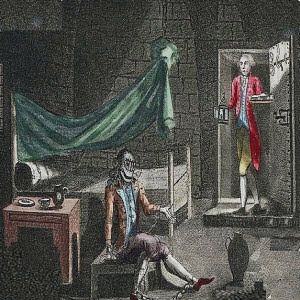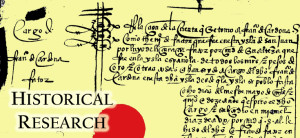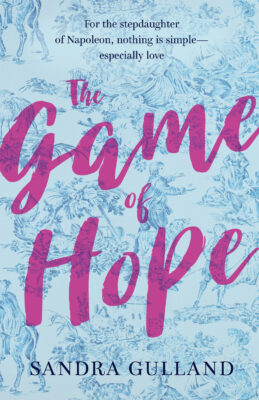
The Game of Hope: a bibliography
This bibliography is the list of books and magazine articles I consulted in writing The Game of Hope. Some of them I consumed, others I simply scanned, looking for one particular fact. There are a number I’ve not listed — the annotated works of Jane Austen, for example, a number of which I consumed. Also, please note that I am not an academic, and have not used correct bibliographic style. Should you wish any further information about any of these references, please contact me.
- —. De la naissance à la glorie: Louis XIV a Saint-Germain, 1638-1682. Musée des Antiquités Nationales; Saint-Germain-en-Laye; 1988.
- — . A Guide to the Wrightman Galleries. The Metropolitan Museum of Art; NY; 1979.
- — . Decorum; A Practical Treatise on Etiquette & Dress of the Best American Society 1879. Westvaco; 1979.
- — . Eugène de Beauharnais; honneur & fidélité.
- — . The Gentlemen’s Book of Etiquette and Manual of Politeness. Hesperus Press Ltd.; London; 2014 (but first published in 1860).
- — . The reign of terror: a collection of authentic narratives of the horrors committed by the revolutionary government of France under Marat and Robespierre, Volume 1. W. Simpkin and R. Marshall; place; January 1, 1826.
- —. Joséphine et Napoléon; L’Hôtel de la Rue de la Victoire. Musée national des châteaux de Malmaison et Bois-Préau; Paris; 2013.
- —. La Reine Hortense; Une femme artiste. Malmaison; Paris?; May 27 – September 27 1993. —. Lucien Bonaparte et Ses Mémoires, 1775-1840. G. Charpentier; Paris; 1882.
- —. Madame Campan (1752 – 1822). Château de Malmaison; Rueil-Malmaison; 1972. Catalog of an exhibition.
- Abbott, John S. C. Hortense.
- Al-Jabarti. Napoleon in Egypt. Translated by Shmuel Moreh. Markue Wiener Publishing; Princeton & NY; 1993.Alméras, Henri d’. La Vie parisienne sous le Consulat et l’Empire. Cercle du Bibliophile. Albin Michel; Paris.
- Anderson, James M. Daily Life during the French Revolution. Greenwood Press; Westport; 2007.
- Atteridge, A. Hilliard. Joachim Murat, marshal of France and king of Naples. Brentanos; NY; 1911.
- Aulard, A. Paris pendant la Réaction Thermidorienne et sous le Directoire. Tome V (July 21 ’98 to Nov. 10 ’99) Maison Quantin; Paris;1902.
- Aulard, A. Paris sous le consulat. Vol. I. Maison Quantin, Paris; 1903.
- Baldassarre, Antonio. Music, Painting, and Domestic Life: Hortense de Beauharnais in Arenenberg. An article published in Music in Art XXIII/1-2 (1998).
- Bear, Joan. Caroline Murat. Collins; London; 1972.
- Bergh, Anne de, and Joyce Briand. 100 Recipes from the Time of Louis XIV. Trans. by Regan Kramer. Archives & Culture; Paris; 2007.
- Bertaud, Jean-Paul. Historie du Consulat et de l’Empire; Chronologie commentée 1799-1815. Perrin; Paris; 1992.
- Bouissounouse, Janine. Julie: the life of Mlle de Lespinasse. Appleton-Century-Crofts; NY; 1962.
- Branda, Pierre. Joséphine; Le paradoxe du cygne. Perrin; Paris; 2016.
- Bretonne, Restif de la. Monsieur Nicolas; or The Human Heart Laid Bare. Translated, edited etc. by Robert Baldick. Barrie and Rockliff; London; 1966.
- —. Sara. John Rodker, for subscribers; London; 1927.
- Bruce, Evangeline. Napoleon and Josephine; The Improbable Marriage. A Lisa Drew Book. Scribner; New York; 1995.
- Buchon, Jean Alexandre. Correspondance Inédite De Mme Campan Avec La Reine Hortense, Tome 1. (Replica.) Book Renaissance; 1835.
- Burney, Fanny, edited by Joyce Hemlow. Fanny Burney; Selected Letters and Journals. Oxford Univ. Press; Oxford; 1987.
- Burton, June K. Napoleon and the Woman Question; Discourses of the Other Sex in French Education, Medicine, and Medical Law 1799 – 1815. Texas Tech University Press; Texas; 2007.
- Campan, Madame. Edited by M. Maigne. The Private Journal of Madame Campan, comprising original anecdotes of the French court; selections from the correspondence, thoughts on education, etc. etc. Nabu Public Domain Reprints of the book published by Abraham Small; Philadelphia; 1825.
- Capellanus, Andreas. The Art of Courtly Love. Columbia Univ. Press; NY; 1960.
- Carlton, W.N.C. Pauline, Favorite Sister of Napoleon.
- Catinat, Maurice. Hortense chez Madame Campan (1795 – 1801), d’après des lettres inédites. Souvenir napoléonien; Paris; 1993.
- —. Madame Campan ou l’éducation des nouvelles élites. An article in Napoléon 1er, #17. Napoléon 1er; France; Nov/Dec 2002.
- Chevallier, Bernard. Malmaison en dates et en chiffres.
- —. Vues du château et du parc de Malmaison. Perrin; Paris.
- Clark, Anna. Desire; A History of European Sexuality. Routledge; NY & London; 2008.
- Connelly, Owen. The Gentle Bonaparte.
- Decker, Ronald; Depaulis, Thierry; Dummett, Michael. A Wicked Pack of Cards; The Origins of the Occult Tarot. Duckworth; London; 2002.
- Delage, Irène, and Chantal Prevot. Atlas de Paris au Temps de Napoleon. Parigramme; Paris; 2014.
- Desan, Suzanne. The Family on Trial in Revolutionary France. Univ. of Calif. Press; Berkeley; 2006.
- Dickens, Charles. A Tale of Two Cities. A Reader’s Companion; Annotated Edition, With 780 Notes. Preface, Annotations, & Appendices by Susanne Alleyn. Spyderwort Press; Albany, NY; 2014.
- Ducrest, C. Mémoires sur L’Impératrice Joséphine; La Cour de Navarre & La Malmaison. Modern-Collection; Paris.
- Duthuron, Gaston. La Révolution 1789-1799. Librairie Arthème Fayard; Paris; 1954.
- Dwyer, Philip. Citizen Emperor; Napoleon in Power 1799-1815. Bloomsbury; London; 2013.
- Eveleigh, David J. Privies and Water Closets. Shire Publications; UK; 2011.
- Fain, Baron. Napoleon: How He Did It. Foreword by Jean Tulard. Proctor Jones Publishing Co.; SF, USA; 1998.
- Feydeau, Elisabeth de. A Scented Palace; the Secret History of Marie Antoinette’s Perfumer. Translated by Jane Lizop. I.B. Tauris; London; 2006.
- Fierro, Alfred. Dictionnaire du Paris disparu. Parigramme; 1998; Paris.
- Flandrin, Jean-Louis. Translated by Julie E. Johnson. Arranging the Meal; A History of Table Service in France. Univ. of Calif. Press; Berkeley; 2007.
- Fullerton, Susannah. A Dance with Jane Austen; How a Novelist and Her Characters Went to a Ball. Frances Lincoln Ltd; London; 2012.
- Garros, Louis and Jean Tulard. Itinérire de Napoléon au jour le jour 1769-1821. Librairie Jules Tallandier; France; 1992.
- Germann, Jennifer. Tracing Marie-Eléonore Godefroid; Women’s Artistic Networks in Early Nineteenth-Century Paris. The Johns Hopkins University Press; place; 2012.
- Gershoy, Leo. The French Revolution and Napoleon. Appleton-Century-Crofts; New York; 1964.
- Giovanangeli, Bernard. (Éditeur) Hortense de Beauharnais. Bernard Giovanangeli Éditeur; Paris; 2009.
- Girardin, Stanislas de. Mémoires. Paris; 1834.
- Goodman, Dena. Becoming a Woman in the Age of Letters. Cornell University Press; Ithaca and London; 2009.
- Gueniffey, Patrice. Bonaparte, 1769 – 1802. Trans. by Steven Rendall. The Belknap Press of Harvard University Press; Cambridge, Mass. & London; 2015.
- Guerrini, Maurice. Napoleon and Paris; Thirty Years of History. Trans., abridged and edited by Margery Weiner. Walker and Company; New York; 1967.
- Haig, Diana Reid. The Letters of Napoleon to Josephine. Ravenhall Books; UK; 2004.
- Hibbert, Christopher. Napoleon: His Wives and Women. (On Google books.)
- Hickman, Peggy. A Jane Austen Household Book. David & Charles; London etc.; 1977.
- Hopkins, Tighe. The Women Napoleon Loved. Kessinger Pub Co; place; 2004.
- Hortense. The Memoirs of Queen Hortense. Edited by Jean Hanoteau. Trans. by Arthur K. Griggs. Vol I & II.
- Hubert, Gérard and Nicole Hubert. Châteaux de Malmaison et de Bois Préau. Ministère de la Culture; Paris; 1986.
- Hubert, Gérard. Malmaison. Trans. by C. de Chabannes. Editions de la Réunion des musées nationaux, Paris 1989.
- Huggett, Jane, and Ninya Mikhaila. The Tudor Child; Clothing and Culture 1485 to 1625. Fat Goose Press; UK; 2013.
- Jacobs, Diane. Her Own Woman; The Life of Mary Wollstonecraft. Simon & Schuster; NY; 2001.
- Joannis, Claudette. Josephine Imperatrice de la Mode; L’élégance sous l’Empire.
- Johnson, R. Brimley. Fanny Burney and the Burneys. Stanley Pau & Co. Ltd.; London; 1926.
- Katz, Marcus, and Tali Goodwin. Learning Lenormand; Traditional Fortune Telling for Modern Life. Llewellyn Publications; Woodbury, Minnesota; 2013.
- Knapton, Ernest John. Empress Josephine. Cabridge, Massachusetts, 1963. Harvard University Press.
- Le Normand, Mlle. M. A. The Historical and Secret Memoirs of the Empress Josephine. Jacob M. Howard, translator. H. S. Nichols. London. 1895. Vol. I and II. Originally published in France 1820.
- Lefébure, Amaury, and Bernard Chavallier. National Museum of the Châteaux de Malmaison et de Bois-Préau. Museum; Montgeron; 2013.
- Lofts, Norah. A Rose for Virtue. (A novel.) Doubleday; NY; 1971.
- Mali, Millicent S. Madame Campan: Educator of Women, Confidante of Queens. Univ. Press of America; Washington DC; 1979.
- Mangan, J.J. The King’s favour; Three eighteenth-century monarchs and the favourites who ruled them. St. Martin’s Press; NY; 1991.
- Mansel, Philip. The Eagle in Splendour; Napoleon I and His Court. George Philip; London; 1987
- Marchand, Louis-Joseph. In Napoleon’s Shadow. (Marchand’s memoirs.) Preface by Jean Tulard. Proctor Jones; SF, Calif.; 1998.
- Marsangy, L. Bonneville de. Mme Campan À Écouen. Champion; 1879.
- Martineau, Gilbert. Caroline Bonaparte; Princess Murat, Reine de Naples. Éditions France-Empire; Paris; 1991.
- Masson, Fredéric. Joséphine, impératrice et reine. Jean Boussod, Manzi, Joyant & C.; Paris; 1899. On Gallica.
- Masson, Frédéric. La Société sous le consulat. Flammarion.
- —. Mme Bonaparte (1796-1804). Deuxième Edition. Librairie Paul Ollendorff; Paris; 1920.
- —.Napoléon et sa famille. Vol. I (1769-1802) Librairie Paul Ollendorff; Paris; 1897.
- —. Napoléon et sa famille. Vol. VIII (1812-1813) Librairie Paul Ollendorff; Paris; 1907.
- Mayeur, Françoise. L’´education des filles en France au XIXiem siècle. Perrin; place; 2008.
- McCutcheon, Marc. The Writer’s Guide to Everyday Life in the 1800s. Writer’s Digest Books, Cincinnati, Ohio, 1993.
- McKee, Eric. Decorum of the Minuet, Delirium of the Waltz. Indiana Univ. Press; Bloomington & Indianapolis; 2012.
- McPhee. Living the French Revolution, 1789-1799. Palgrave Macmillan; NY; 2009.
- Millot, Michel. The school of Venus, or the ladies delight, Reduced into rules of Practice; Being the Translation of the French L’Escoles des filles ; in 2 Dialogues. 1680.
- Mills, Joshua W. Imitatio Techniques from Classical Rhetorical Pedagogy. (A thesis) Johns Hopkins University; Baltimore; May 2010.
- Montagu, Violette M. Eugène de Beauharnais; The Adopted Son of Napoleon. John Long, Limited; London; MCMXIII.
- —. The Celebrated Madame Campan. Bibliolife, but originally published by Eveleigh Nash; 1914; London.
- Montjouvent, Philippe de. Joséphine; Une impératrice de légendes. Timée Éditions; France; 2010.
- Oman, Carola. Napoleon’s Viceroy; Eugène de Beauharnais. Hodder and Stoughton; London; 1966.
- Osmond, Marion W. Jean Baptiste Isabey; The Fortunate Painter.
- Pannelier, Alexandrine. Hortense et Eugène de Beauharnais à Saint-Germain. from her souvenirs. Bulletin 1981, Société des Amis de Malmaison.
- Parkes, Mrs. William. Domestic Duties; or Instructions to Young Married Ladies on the management of their households, and the regulation of their conduct in the various relations and duties of Married Life. Pub; New York; 1829.
- Pawl, Ronals. Napoleon’s Mounted Chasseurs of the Imperial Guard.
- Pellapra, Emilie de, Comtesse de Brigode, Princess de Chimay. A Daughter of Napoleon; Memoirs of Emile de Pellapra, Comtesse de Brigode, Princess of Chimay. Introduction by Princess Bibesco. Preface by Frederic Masson. Translated by Katherine Miller. Charles Scribner’s Sons; New York; 1922.
- Pitt, Leonard. Promenades dans le Paris Disparu. Parigramme; place; 2002.
- Prod’homme, J.—G., and Frederick H. Martens. Napoleon, Music and Musicians. The Musical Quarterly, Vol. 7, No. 4, pp 579-605, Oct. 1921.
- Reichardt, J. -F. Un Hiver a Paris sous le Consulat. (1802-1803). Librairie Plox E. Plon; Paris; 1896.
- Reval, Gabrielle. Madame Campan, Assistante de Napoléon. Albin Michel; Paris.
- Richardson, Samuel. Letters written to and for particular friends, on the most important occasions. Directing not only the requisite style and forms to be observed in writing familiar letters; but how to think and act justly and prudently. (reprint by Gale ECCO Print Editions); originally London; originally 1741.
- Robiquet, Jean. Daily Life in France Under Napoleon.
- —. Daily Life in the French Revolution. James Kirkup, trans. The Macmillan Co. New York, 1965.
- Rogers, Rebecca. From the Salon to the Schoolroom, Educating Bourgeois Girls in Nineteenth-Century France. Penn State Univ. Press; Univ. Park, Penn.; 2005.
- Saint-Amand, Imbert de. The Wife of the First Consul. Trans. by T. S. Perry. Scribner’s; NY; 1890.
- Sand, George. Lettres d’un Voyageur. Penguin; Englan; 1987 (from original 1837).
- Savine, Albert. Les Jours de la Malmaison. Louis-Michaud; Paris; 1909.
- Schama, Simon. Citizens, A Chronicle of the French Revolution. New York, 1989. Alfred A. Knopf.
- Schlogel, Gilbert. Émilie de Lavalette; Une légende blessée. France Loisirs; Paris; 1999.
- Seward, Desmond. Napoleon’s Family. Viking; New York; 1986.
- Shields, Carol. Jane Austen. A Penguin Life. A Lipper/Viking Book; NY; 2001.
- Steinbach, Sylvie. The Secrets of the Lenormand Oracle. Self-published; na; 2007.
- Stuart, Andrea. The Rose of Martinique; a life of Napoleon’s Josephine.
- Sullivan, Margaret C. The Jane Austen Handbook. Quirk books; Philadephia; 2007.
- Tour, Jean de la. Duroc (1772-1813). Nouveau Monde Editions; Paris; 2004.
- Turquan, Joseph. The Sisters of Napoleon; Elisa, Pauline and Caroline Bonaparte After The Testimony of Their Contemporaries. Isha Books; India; 1908 (2013).
- Warner, Sylvia Townsend. Jane Austen. Longman Group Ltd.; 1964; 1970.
- Weiner, Margery. The Parvenu Princesses. William Morrow & Co; NY; 1964.
- Whatman, Susanna. The Housekeeping Book of Susanna Whatman (1776-1800). Century; London; 1987. Originally published in 1776.
- Whitcomb, Edward A. Napoleon’s Diplomatic Service. Duke University Press; Durham, N.C.; 1979.
- Williams, Kate. Josephine; Desire, Ambition, Napoleon. Hutchinson; London; 2013.
- Winegarten, Renee. Germaine de Staël & Benjamin Constant; A Dual Biography. York University Press; New Haven and London;2008.
- Wright, Constance. Daughter to Napoleon; a biography of Hortense, Queen of Holland. Holt, Rinehart and Winston; NY; 1961.
{Photo above by Giammarco Boscaro on Unsplash.}

